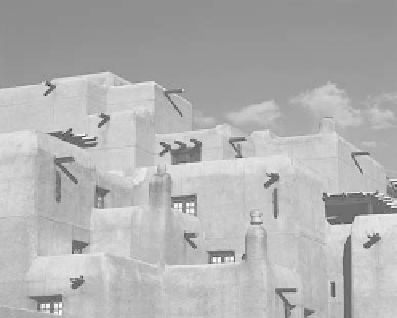Travel Reference
In-Depth Information
Hotel accommodations
should be planned to blend
in and enhance the
surrounding environment
so tourists will want to visit.
The Loretto Inn, Sante Fe,
New Mexico, sits at the end
of the Santa Fe Trail and
blends in with its
surroundings.
Photo
courtesyofCorbis
DigitalStock.
Financing Procedures
A group interested in building a resort must convince the local city, regional, or national authorities
that the resort should be built. The next step is to obtain a suitable site designated for construction
under a previously completed tourist development plan for the area. A third-party feasibility study
should be undertaken.
To indicate that this group is seriously interested in building a resort, architects, engineers,
consultants, and other specialists should be contacted during the planning phase. The organization
that is to operate the resort should be the same group that builds the hotel. An important planning
ingredient is the recommendation of experienced resort managers concerning design and layout of the
project.
The next step is to obtain construction capital either from local sources or from government or
foreign sources. Also, capital must be secured for equipment, supplies, and services, including opening
expenses and pre
break-even expenses. Government aid in obtaining imported supplies and equip-
ment is often necessary.
Governmental consideration should be given for reduction or elimination of taxes for an adequate
length of time to help ensure the
financial success of the resort venture. Elimination of import duties
on materials needed to build and run resorts is also desirable.
-
SUMMARY
This chapter opens with the presentation of a model that identi
es and explains those factors that
fundamentally determine the competitiveness, sustainability, and success of tourism destinations. It
then examines the nature and necessity of tourism planning and development, as well as the distinct
characteristics of each process. Subsequently, discussion focuses on the importance of relating policy
to planning with a view to achieving a meaningful integration of the two processes.
The quality of tourism planning and development will determine the ultimate success and
longevity of any destination area. Thus, time, effort, and resources devoted to planning are essential
investments.
Thoughtful planners have formulated the goals for tourism development, and these should be
guiding principles everywhere. Obstacles must be overcome by sound planning augmented by political
means, if growth is desired. This is often accomplished by the of
cial tourism body. Tourism
development should be a part of the overall regional or urban land-use development plan.
Tourism developments almost always involve both government and private developers. Each
sector can best contribute certain parts of a project. Government typically provides the infrastructure,
such as roads, water supply, sewers, public transportation terminals, and parks. Private developers
supply superstructure, such as hotels, restaurants, recreation facilities, and shopping areas.










Search WWH ::

Custom Search